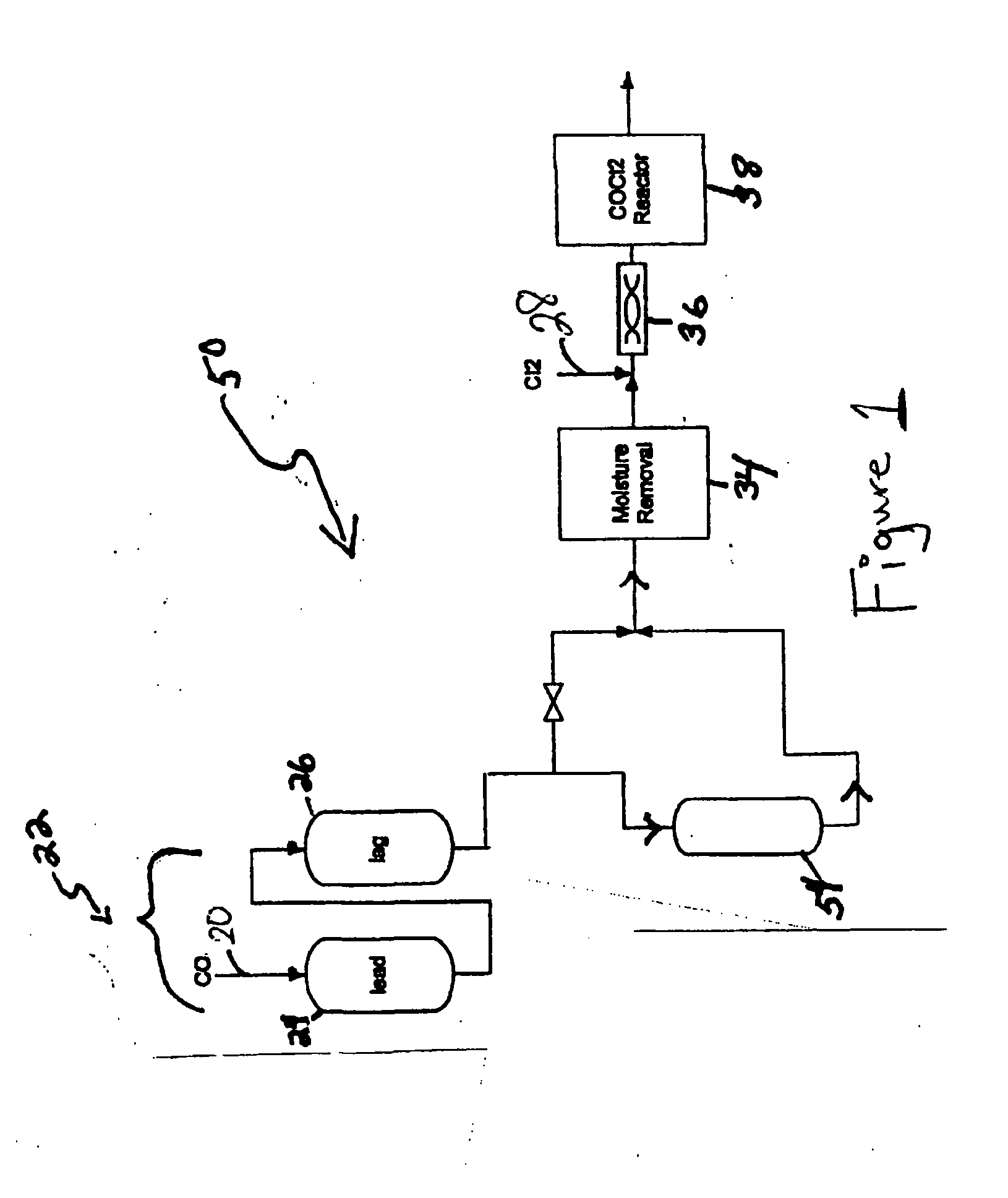Processes and systems for making phosgene
a technology of phosgene and process, applied in the preparation of carboxylic acid halides, physical/chemical process catalysts, separation processes, etc., can solve the problem of less than the capacity of activated carbon to remove hsub>2/sub>s, sulfur deposits on the phosgene catalyst in the reaction chamber, sulfur deposits in downstream equipment, etc., to reduce the concentration of hydrogen sulfide
- Summary
- Abstract
- Description
- Claims
- Application Information
AI Technical Summary
Benefits of technology
Problems solved by technology
Method used
Image
Examples
example 1
Removal of Sulfur Compounds Using BPL® Activated Carbon Only
[0029] Referring to FIG. 1, a carbon monoxide gas stream comprising 4,630 ppm COS, 1,991 ppm CS2, and 118 ppm H2S, passed through the first sulfur removal unit (22); passing through both the lead position sub-unit (24) and then through the lag position sub-unit (26) at a rate of at 8,000 pounds per hour (lbs / hr). Both lead and lag sub-units included 30,000 lbs of non-MOI activated carbon composition as the sulfur removal composition, which removed COS and CS2 gases and some hydrogen sulfide gas from the carbon monoxide gas stream. After flowing through the lead and lag positions, the modified stream passed through the moisture removal unit (34) that reduced the water content of the modified stream to 1 ppm before passing mixing with chlorine in the mixer (36) and introduction to the reactor (38) where phosgene was produced.
[0030]FIG. 2 graphically represents the hydrogen sulfide concentration in the modified stream at the...
example 2
Removal of Sulfur Compounds Using BPL® Activated Carbon Followed by a CuO-Impregnated Activated Carbon
[0031] The process in Example 1 was repeated with the difference being the use of a polishing bed; namely a CuO-impregnated activated carbon sulfur removal unit (54) disposed downstream of the sulfur removal unit (22). This sulfur removal unit (54) comprised 15,000 lbs CuO impregnated activated carbon (i.e., NUSORB FC).
[0032] A carbon monoxide gas stream comprising 4,630 ppm COS, 1,991 ppm CS2, and 118 ppm H2 S, passed through the first sulfur removal unit (22) comprising BPL® activated carbon; passing through both the lead position sub-unit (24) and then through the lag position sub-unit (26) at a rate of at 8,000 pounds per hour (lbs / hr). Both lead and lag sub-units included 30,000 lbs of non-MOI activated carbon composition as the sulfur removal composition, which removed COS and CS2 gases to produce a modified stream.
[0033] After flowing through the lead and lag positions, th...
PUM
| Property | Measurement | Unit |
|---|---|---|
| temperature | aaaaa | aaaaa |
| temperature | aaaaa | aaaaa |
| pressure | aaaaa | aaaaa |
Abstract
Description
Claims
Application Information
 Login to View More
Login to View More - R&D
- Intellectual Property
- Life Sciences
- Materials
- Tech Scout
- Unparalleled Data Quality
- Higher Quality Content
- 60% Fewer Hallucinations
Browse by: Latest US Patents, China's latest patents, Technical Efficacy Thesaurus, Application Domain, Technology Topic, Popular Technical Reports.
© 2025 PatSnap. All rights reserved.Legal|Privacy policy|Modern Slavery Act Transparency Statement|Sitemap|About US| Contact US: help@patsnap.com



